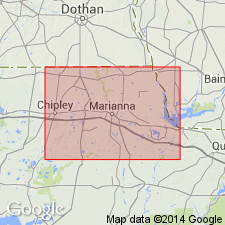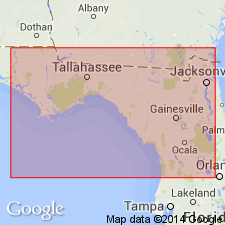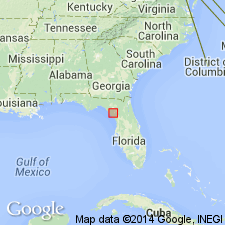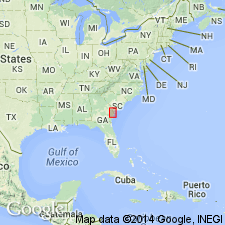
- Usage in publication:
-
- Gadsden limestone
- Modifications:
-
- Original reference
- Dominant lithology:
-
- Limestone
- AAPG geologic province:
-
- South Georgia sedimentary province
Summary:
Pg. 21 (table 1), 30, 42-44. Gadsden limestone of Ocala group. Introduced for some limestones of Jackson age that occur in subsurface sections of southeastern Jackson County, northwestern Florida. Consists of those limestones that have no, or few, specimens of the larger Foraminifera such as LEPIDOCYCLINA, ASTEROCYCLINA, or OPERCULINOIDES. Underlain in Jackson County by Marianna limestone. Stratigraphic equivalent of Crystal River formation which includes the Bumpnose member. Grades laterally into Crystal River formation, and youngest Gadsden beds extend farthest to northwest. Depending upon where the Gadsden is encountered, it is underlain by the Crystal River formation or by older Eocene formations. Overlies Tallahassee limestone in well W-4 in Gadsden County, northwestern Florida. Thickness 0 to 180 feet in Jackson County. Gadsden is confined to area southeast of Cypress fault, and from fault it thickens to southeast at expense of Crystal River.
Named from occurrence in City of Quincy water well W-4, Gadsden Co., northwestern FL.
Source: US geologic names lexicon (USGS Bull. 1200, p. 1450).

- Usage in publication:
-
- Gadsden limestone
- Modifications:
-
- Not used
- AAPG geologic province:
-
- South Georgia sedimentary province
Summary:
Pg. 34-35. Gadsden limestone of Ocala group. Appears to be a faunal facies of the Crystal River. Suggested that name be abandoned.
Source: US geologic names lexicon (USGS Bull. 1200, p. 1450).

- Usage in publication:
-
- Gadsden Member
- Modifications:
-
- Revised
- AAPG geologic province:
-
- South Georgia sedimentary province
Summary:
Gadsden is here used as a member of the Crystal River Formation in the panhandle of FL. Age is Eocene. This agrees with the usage of Puri and Vernon (1964), though in 1957, Puri had suggested abandonment.
Source: GNU records (USGS DDS-6; Reston GNULEX).

- Usage in publication:
-
- Gadsden
- Modifications:
-
- Not used
- AAPG geologic province:
-
- South Georgia sedimentary province
Summary:
Both the Tallahassee and the Gadsden Formations are "subsumed" under the newly named Oligocene Ochlockonee Formation of this report. Lower part of the Ochlockonee was previously included in the Tallahassee Limestone, while the upper part was included in the Gadsden Limestone. The name Tallahassee limestone of Applin and Applin (1944) is not reintroduced as a name for this formation because no type well was ever designated and as described it is stratigraphically inconsistent. The Gadsden is not used because it would take major revision and expansion of the original concept of the formation.
Source: GNU records (USGS DDS-6; Reston GNULEX).
For more information, please contact Nancy Stamm, Geologic Names Committee Secretary.
Asterisk (*) indicates published by U.S. Geological Survey authors.
"No current usage" (†) implies that a name has been abandoned or has fallen into disuse. Former usage and, if known, replacement name given in parentheses ( ).
Slash (/) indicates name conflicts with nomenclatural guidelines (CSN, 1933; ACSN, 1961, 1970; NACSN, 1983, 2005, 2021). May be explained within brackets ([ ]).

